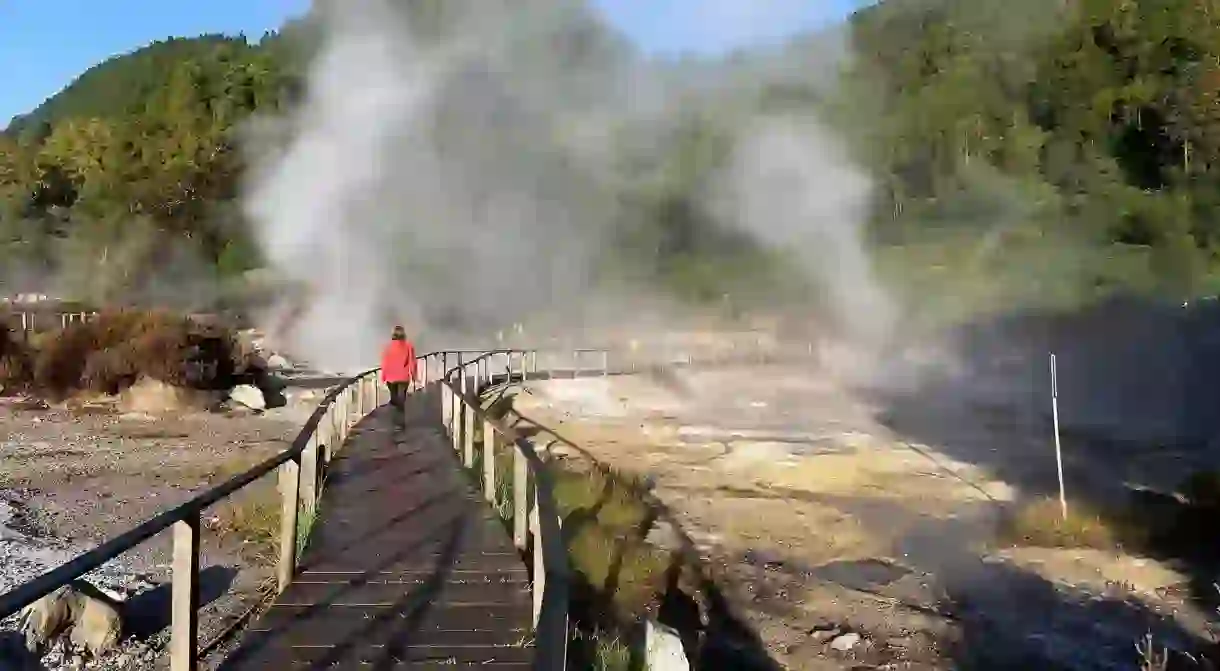What Not to Miss on São Miguel Island in the Azores

If you need a starting point in this necklace of nine mid-Atlantic islands, make it this scenic speck of geothermal pools, crater lakes and steaming fumaroles.
Rattling along the lanes of São Miguel – the main island in the Azores – you know you’re somewhere special. Bursts of hydrangea bushes merge with yellow honeysuckle and giant heart-shaped yams. Whitewashed houses bear age-old azulejo tiles and time-worn terracotta roofs. Out of nowhere, rainbows arch and volcanic landmarks loom. It would be all too easy to drive around all day, letting nature do its work. But if you really want to know the best viewpoints, thermal springs and places to spot whale fins flick through the water, follow this insider’s guide to the best things to do in São Miguel.
Fill your belly to the brim on Azorean food
Architectural Landmark

Fado singer and guitarist Rafael Fraga is the man behind Hungry Whales – a food tour that showcases the rich Azorean larder. On a three-hour odyssey around São Miguel’s capital Ponta Delgada, you’ll learn how the island’s mild microclimate and rich volcanic soil has given rise to a countryside plotted with pineapple plantations, vineyards and 18th-century teahouses. As you walk around the city, you’ll learn about Azorean wines, sweetbreads, local cheeses and lava cakes, via tastings in the Mercado da Graça farmers’ market and stops at restaurants such as A Tasca – where flambéed “fireman’s-style” sausages are served on the site of a former jail.
Sip the good stuff at Europe’s oldest tea factory
Shop

Six generations of the same family have gone into the making of Chá Gorreana – the oldest tea factory in Europe. You’ll find the historic plantation in a scenic oceanside spot overlooking the north coast near Ribeira Grande. It’s a worthy visit, not only for views of glossy green tea fields rippling down to the Atlantic, but also for admiring century-old machinery, brought in from England and India, and tasting organic single-estate brews – which you can buy before they’re exported around the world.
Cut loose at an experimental music festival
Natural Feature

Much as Iceland has a distinct music scene that thrives in isolation and looks to nature for inspiration, so too does the Azores. After all, only on an island chain where whales summit the water, volcanoes rise, fumaroles boil and rainbows dome the horizon could you find a festival as weird and wonderful as Tremor. This beard-stroking experimental cultural outing centres around a series of secret events, hosted in hidden locations such airport hangars, thermal pools, and cliffsides overlooking volcanic craters. It takes place in April each year, but with only 1,000 tickets released annually, you’ll have to be quick.
Tick off 28 different species of whale
Natural Feature

Lining Ponta Delgada harbour are various whale-watching tours. But the oldest (and most environmentally sound) is Futurismo, which offers three-hour tours led by marine biologists through moody Atlantic waters, where you can spot up to 28 different whale species. Spring months (from April to June) are best, with fin, sei and blue whales migrating through – the latter reaching up to 30m (100ft) and weighing 200 tonnes, making it the largest animal ever to have existed. Travelling outside that window? Fear not: sperm whales and pods of Risso’s, bottlenose and common dolphins are resident and regular sightings whatever the season.
Grab a scenic snapshot of the Azores
Natural Feature

In the extreme wild west of São Miguel, the dormant Sete Cidades volcano spans 5km (3mi) and shelters within its soaring walls two crater lakes (one blue, one green). Seen together, the spectacle makes for one of Mother Nature’s most mic-drop moments – the type where you’ll be urging your driver to stop every two seconds to capture the view. Various viewpoints snake the caldera edge or you can hike around the rim. Futurismo offers biking, kayaking and Jeep tours that chug along quiet country roads.
See smoke and sulphur rise from the ground
Natural Feature

“Double, double toil and trouble… Fire burn and caldron bubble,” might well have been written about the Furnas area – such is the occult, otherworldly atmosphere of this simmering hotbed of volcanic activity in the eastern part of São Miguel. In Furnas, you’ll see fumaroles spiralling through the air, smell the scent of sulphur as you weave around misty volcanic pools and see how hearty cozido stew is cooked underground using natural geothermal energy. Local outfit Magic Tours run trips, which include a stop to swim in the thermal pools and botanical gardens of Terra Nostra.
Take wild swimming to the next level
Natural Feature

Swimming off Bournemouth beach in the bitter depths of winter might have a special allure for some. But it can’t compete with doing laps in a volcanic crater or diving into thermal springs in the Azores. The crescent-shaped islet of Vila Franca do Campo offers the chance to snorkel in the shell of an ancient submerged volcano, 1km off the north coast of São Miguel. From June to October, hop on a boat from the Tagarete pier, taking everything you need to make a day of it. Another favourite swimming spot is Termas da Ferraria, where you can join the mostly local crowd to take in the waters of a geothermal sea pool – half warmed to 40C (104F), half cooled by incoming swells.
Soak up sunset by the sea with locals
Architectural Landmark

The south-coast fishing village of Caloura is one of the most sought-after spots on the island for a summer swim, thanks to its scenic sea pool jutting into the water, sheltered by soaring basalt walls. There’s also a small black-sand beach around the next bay at Baixa D’Areia. Afterwards, grab a table on the sea-facing terrace of Bar Caloura at sunset for chilled glasses of Azorean wine and platters of fresh shellfish, caught that day in the waters just in front.













